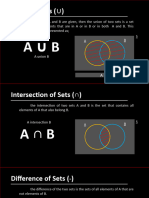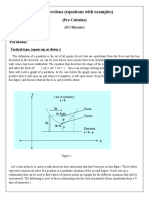Programming Homework Help
Uploaded by
Programming Homework HelpProgramming Homework Help
Uploaded by
Programming Homework HelpProgramming Homework Help
Problem 1. Exact Edges
Given a weighted, directed graph G = (V, E,w) with positive and negative
edge weights, and given a particular vertex v ∈ V , describe an O(k|E|)-
time algorithm to return the minimum weight of any cycle containing
vertex v that also has exactly k edges, or return that no such cycle exists.
Recall that a cycle may repeat vertices/edges.
Solution: Assume all vertices in G are reachable from v so that |V | = O(|
E|); otherwise, run BFS or DFS to solve single source reachability from v,
and replace G with the subgraph reachable from v in O(|E|) time.
Construct a new graph G0 = (V 0 , E0 ) with:
• k + 1 vertices for each vertex v ∈ V : specifically vi for all i ∈ {0, . . . ,
k}; and
• k edges for each edge (u, v) ∈ E: specifically edges (ui-1, vi) for all i ∈
{1, . . . , k}.
Graph G0 has (k + 1)|V | = O(k|E|) vertices and k|E| edges in k + 1 layers,
and has the property that paths from v0 to vk have a one-to-one
correspondence with cycles through v in G of the same weight containing
exactly k edges, since exactly one edge is traversed with each increase in
layer. So solve SSSP from v0 in G0 to return the minimum weight path to
vk. Since edges in G0 always increase in subscript, G0 is a DAG, so we
can solve SSSP using DAG relaxation in linear time with respect to the
size of G0 . So together with initial pruning, this algorithm takes O(k|E|)
time in total.
Common Mistakes:
• Using BFS to detect cycles in a directed graph (need DFS)
• Trying to enumerate all paths or cycles of length k (may be exponential)
© 2022 All Rights Reserved . Programming Homework Help
• Using Bellman-Ford without removing zero-weight edges (may use
fewer than k edges)
• Finding cycles using k - 1 edges, not k edges
• Trying to find negative-weight cycles (wrong problem)
• Not running a reachability algorithm to prune to graph reachable from
v
Problem 2. Color Cost
A 3-color labeling of a graph maps each edge to either red, green, or blue.
The color cost of a 3-color labeled path is its path weight plus a positive
integer wc every time the path changes color.
For example, in the graph below (having four vertices {a, b, c, d}, a blue
edge (a, b) with weight w1, a red edge (b, c) with weight w2, and another
blue edge (c, d) with weight w3) the path (a, b, c, d) has color cost w1 +
w2 + w3 + 2wc, because the path changes color twice.
Given a 3-color labeling c : E → {red, green, blue} of a connected,
weighted, undirected graph G = (V, E,w) containing only positive edge
weights, and given two vertices s,t ∈ V , describe an efficient algorithm to
return a path from s to t having minimum color cost. (By “efficient”, we
mean that faster correct algorithms will receive more points than slower
ones.)
Solution: Construct a new graph G0 = (V 0 , E0 ) with:
© 2022 All Rights Reserved . Programming Homework Help
• 3 vertices for each vertex v ∈ V : specifically vi for i ∈ {red, green,
blue} corresponding to arriving at vertex v via an edge with color i;
• (vertex-edges) 3 undirected edges for each vertex v ∈ V : specifically
{vred, vblue}, {vgreen, vred}, and {vblue, vgreen} of weight wc; and
• (edge-edges) 1 undirected edge for each undirected edge {u, v} ∈ E of
weight w and color c(u, v): specifically undirected edge {uc(u,v), vc(u,v)}
with weight w.
Graph G0 has 3|V | vertices and 3|V | + |E| edges, and has the property that
the minimum weight of any path in G0 from any vertex si to any vertex tj
for i, j ∈ {red, green, blue} is equal to the minimum color cost of any 3-
color labeled path in G from s to t, as switching colors at a vertex requires
traversing an edge of weight wc. So solve SSSP three times, once from
each vertex si and find the minimum weight of any path to any tj , and
then return a minimum path by constructing parent pointers as shown in
lecture. Since this graph only has positive edge weights, we can solve
SSSP using Dijkstra in O(|V | + |E| + |V | log |V |) = O(|E| + |V | log |V |)
time.
Note that you can avoid running Dijkstra three times via a supernode, but
this only reduces work by a constant factor. Also, one can also avoid adding
vertex-edges by adding three edges for each edge connected and weighted
appropriately, but these edges will need to be directed toward a vertex
labeled with the same color as the corresponding edge.
© 2022 All Rights Reserved . Programming Homework Help
Common Mistakes:
• Incorrectly trying to modify Dijkstra to keep track of state
• Failing to identify (or identifying incorrectly) a source from which to
run SSSP
• Weighting or directing edges in a duplicated graph incorrectly
Problem 3.
Orkscapade Ranger Raargorn needs to deliver a message from her home
town of Tina’s Mirth to the town of Riverdell, but the towns of Midgard
have been overrun by an army of k Orks. Raargorn has a map of the n
towns and 3n roads in Midgard, where each road connects a pair of towns
in both directions. Scouts have determined the number of Orks ri ≥ 1
stationed in each town i (there is at least one Ork stationed in each town).
Describe an O(k)-time algorithm to find a path from Tina’s Mirth to
Riverdell on which Raargorn will encounter the fewest total Orks in
towns along the way. Partial credit will be awarded for slower correct
algorithms, e.g., O(k log k) or O(nk).
Solution: Construct a graph G = (V, E) with:
© 2022 All Rights Reserved . Programming Homework Help
• a chain of ri vertices (v1, . . . , vrv ) connected by rv-1 edges for each
town v, i.e., unweighted directed edge (vi, vi+1) for all i ∈ {1, . . . , rv -
1}; and
• two unweighted directed edges (uru , v1) and (vrv , u1) for each road
between towns u and v.
Graph G has v rv = k vertices and 2(3n) + v(rv - 1) = 5n + k edges. Since
there is at least one Ork in each town, k ≥ n, so G has size O(k). Let s and t
correspond to the towns of Tina’s Mirth and Riverdell respectively. Graph
G has the property that any path from s1 to trt corresponds to a path from
Tina’s Mirth to Riverdell crossing edges equal to the number of Orks
encounters in towns along the way, since for any road connecting towns u
and v, going from u1 to v1 requires traversing rv edges in G. So solve
unweighted SSSP from s1 to trt using BFS in O(k) time, and return the
sequence of towns visited along the found shortest path by following parent
pointers.
Common Mistakes:
• Not directing edges with vertex weight, or otherwise not clearly defining
a graph
• Expanding weights on all edges, leading to an O(nk) expansion
• (e.g., a town with Θ(k) Orks may connect to Θ(n) roads)
• Using Dijkstra without modification to achieve an O(k log k)-time
algorithm
• Expanding vertex weights incorrectly (path length ri instead of ri -1)
© 2022 All Rights Reserved . Programming Homework Help
• Finding shortest paths in a BFS or DFS tree (may not contain shortest
paths)
Problem 4. Count Cycles
A cycle-sparse graph is any weighted directed simple graph G = (V,
E,w) for which every vertex v ∈ V is reachable from at most one
simple1 negative-weight cycle in G. Given a cycle-sparse graph,
describe an O(|V | 3)-time algorithm to return the number of
negative-weight cycles in G.
Solution: Construct a new graph G0 by adding a supernode x to G
with a zero-weight directed edge (x, v) for each v ∈ V . Then run
SSSP from x in G0 using Bellman-Ford to label each vertex v ∈ V
with its shortest path distance δ(x, v). For each v ∈ V , δ(x, v) = -∞
if and only if v is reachable from a negative-weight cycle in G (since
adding x does not add or remove any cycles). Further, for any
directed edge (u, v), if δ(x, u) = δ(x, v) = -∞, then both u and v are
each reachable from the same simple negative-weight cycle (since v
is reachable from u and each vertex is reachable from at most one
simple negative-weight cycle).
© 2022 All Rights Reserved . Programming Homework Help
So, construct a new graph G00 on only the vertices v ∈ V where δ(x, v)
= -∞ in G0 , with an undirected edge between u and v in G00 if they
share a directed edge in G. Graph G00 has the property that the number
of connected components in G00 equals the number of negative-weight
cycles in G, so count and return the number of connected components in
G00 using Full-BFS or Full-DFS. This algorithm takes O(|V |+|E|) time
to construct G0 , O(|V ||E|) time to run BellmanFord, O(|V |+|E|) time to
construct G00, and then O(|V |+|E|) time to count connected
components in G00, leading to an O(|V ||E|) = O(|V | 3) running time in
total.
Common Mistakes:
• General lack of precision when describing algorithm
• Trying to enumerate all paths or cycles (may be exponential)
• Repeatedly running Bellman-Ford, generally yielding |V | · O(|V ||
E|) = O(|V | 4) time • Stating that |E| = O(|V |)
• Confusing connected components with strongly connected
components
Problem 5. Bellham’s Fjord
Gralexandra Bellham wants to drive her electric car in Norway from
location s in Oslo to a scenic Fjord at location t. She has a map of the n
locations in Norway and the O(n) one-way roads directly connecting
pairs of them.
© 2022 All Rights Reserved . Programming Homework Help
• Each location x is marked with its (positive or negative) integer
height h(x) above sea-level.
• Her car has regenerative braking allowing it to generate energy
while going downhill. Each road from location x to y is marked with
the integer energy J(x, y) that the electric car will either spend
(positive) or generate (negative) while driving along it.
• By the laws of physics, J(x, y) is always strictly greater than the
difference in potential energy between locations x and y, i.e., J(x, y) >
m · g · (h(y) - h(x)), where m and g are the mass of the car and the
acceleration due to gravity respectively.
Her car battery has very large energy capacity b > 2nk where k is the
maximum |J(x, y)| of any road. Assuming she departs s at half
capacity, bb/2c, describe an O(n log n)-time algorithm to determine
the maximum amount of energy Bellham can have in her battery
upon reaching t. Partial credit will be awarded for slower correct
algorithms, e.g., O(n2).
Solution: Construct graph G with a vertex for each of the n locations in
Norway and a directed edge for each of the O(n) roads: specifically for
each road from location u to v, add directed edge (u, v) weighted by J(u,
v). Then bb/2c minus the weight of a minimum-weight path from s to t in
G would correspond to the maximum energy Bellham could have upon
reaching t; or at least it would be if she did not either exceed or exhaust
her tank along the way.
First we show that every minimum-weight path from s to t in G is simple.
It suffices to show that P every directed cycle in G has positive weight.
Consider cycle (c0, . . . , ck-1, ck = c0). C has weight k Pk J(ci-1, ci) >
mg(h(ci) - h(ci-1)) = 0, as desired.
© 2022 All Rights Reserved . Programming Homework Help
Any simple path in G traverses at most n - 1 edges, so the magnitude of
its weight is at most (n - 1)k < b/2. Thus bb/2c minus the weight of any
simple path in G will always be > 0 and < b (so Bellham cannot exhaust
or exceed her tank by driving on a simple path from s to t).
Lastly, we find the weight of a minimum-weight path from s to t by solving
SSSP. Unfortunately using Bellman-Ford takes O(n2) time which is too
slow. However, we can re-weight edges in G to be positive while
preserving shortest paths by exploiting the provided vertex potentials,
similar to Johnson’s algorithm. Specifically, create new graph G0 ,
identical to G, except change the weight of each edge (u, v) to J(u, v) -
mg(h(v) - h(u)) > 0. This transformation preserves shortest paths since the
weight of each path from, e.g., a to b changes by the same amount, namely
by mg(h(b) - h(a)). So run Dijkstra from s to find the minimum weight D of
any path to t in G0 , and return bb/2c - (D -mg(h(b) - h(a))).
Constructing G takes O(n) time, reweighting to G0 also takes O(n)
time, and then running Dijkstra from s in G0 takes O(n log n) time,
leading to O(n log n) time in total.
Common mistakes continued on S1.
© 2022 All Rights Reserved . Programming Homework Help
You might also like
- GeorgiaTech CS-6515: Graduate Algorithms: Graph Agos Flashcards by Daniel Conner - BrainscapeNo ratings yetGeorgiaTech CS-6515: Graduate Algorithms: Graph Agos Flashcards by Daniel Conner - Brainscape30 pages
- Matchings.: CSCI 5454 H. Gabow Various Semesters P. 1No ratings yetMatchings.: CSCI 5454 H. Gabow Various Semesters P. 17 pages
- CSE 101 Homework 2 Solutions: Winter 2021No ratings yetCSE 101 Homework 2 Solutions: Winter 20213 pages
- f1c1b7a2eaf6685874a4cae34c68b090_MIT6_006S20_review2_solNo ratings yetf1c1b7a2eaf6685874a4cae34c68b090_MIT6_006S20_review2_sol5 pages
- Exercise No. 12: DFS, BFS, Topological-SortNo ratings yetExercise No. 12: DFS, BFS, Topological-Sort6 pages
- Fundamental Problems AND Algorithms Graph Theory and CombinationalNo ratings yetFundamental Problems AND Algorithms Graph Theory and Combinational31 pages
- Graph Algorithms: CSE5311 - Lectures by Prof. Chris DingNo ratings yetGraph Algorithms: CSE5311 - Lectures by Prof. Chris Ding12 pages
- Nguyễn Quốc An (BKC18348) - Assignment 3 lần 2 - Discrete Math - C01K10T 1No ratings yetNguyễn Quốc An (BKC18348) - Assignment 3 lần 2 - Discrete Math - C01K10T 17 pages
- d89a357c7467aa03eef4cc0e7d2a310b_MIT6_006S20_q2No ratings yetd89a357c7467aa03eef4cc0e7d2a310b_MIT6_006S20_q211 pages
- Data Structures and Algorithms: Finding Shortest WayNo ratings yetData Structures and Algorithms: Finding Shortest Way38 pages
- 07 CS316 - Algorithms - Graph 1 - SearchNo ratings yet07 CS316 - Algorithms - Graph 1 - Search59 pages
- Assignment 2 Graph theory - Nguyễn Quốc An BTECC01K10TNo ratings yetAssignment 2 Graph theory - Nguyễn Quốc An BTECC01K10T6 pages
- Elementary Graph Algorithms: Manoj Agnihotri M.Tech I.T Dept of CSE ACET AmritsarNo ratings yetElementary Graph Algorithms: Manoj Agnihotri M.Tech I.T Dept of CSE ACET Amritsar58 pages
- CSE221 _ Lab 04 _ Graph _ Fall 2024 _ Faculty V1No ratings yetCSE221 _ Lab 04 _ Graph _ Fall 2024 _ Faculty V122 pages
- Lecture - 04 - Minimum Spanning Tree (Prim and Krushkal) 2No ratings yetLecture - 04 - Minimum Spanning Tree (Prim and Krushkal) 2154 pages
- Bitwise Class Activity Problem:: Programming Homework Help - Expert Homework HelpersNo ratings yetBitwise Class Activity Problem:: Programming Homework Help - Expert Homework Helpers3 pages
- Chapter 6 - Solving Quadratic EquationsNo ratings yetChapter 6 - Solving Quadratic Equations28 pages
- Ramanujan Type Trigonometric Formulas: The General Form for the Argument 2 π 7No ratings yetRamanujan Type Trigonometric Formulas: The General Form for the Argument 2 π 723 pages
- FX X XX X X: AP Calculus BC:: Quiz One:: Shubleka NameNo ratings yetFX X XX X X: AP Calculus BC:: Quiz One:: Shubleka Name1 page
- CAD GTU Study Material E-Notes Unit-4 08052021103022AMNo ratings yetCAD GTU Study Material E-Notes Unit-4 08052021103022AM20 pages
- MATH 1342 Elementary Statistics Prerequisite ReviewNo ratings yetMATH 1342 Elementary Statistics Prerequisite Review8 pages
- Full Download Linear Algebra and Group Theory For Physicists and Engineers 2nd Edition Yair Shapira PDFNo ratings yetFull Download Linear Algebra and Group Theory For Physicists and Engineers 2nd Edition Yair Shapira PDF49 pages
- Eee-Vi-Digital Signal Processing (10ee64) - Notes PDF85% (20)Eee-Vi-Digital Signal Processing (10ee64) - Notes PDF150 pages
- Symbolic Math Toolbox: Quick Reference SheetNo ratings yetSymbolic Math Toolbox: Quick Reference Sheet2 pages
- CBSE Class 12 Maths Chapter-2 Inverse Trigonometric Functions FormulaNo ratings yetCBSE Class 12 Maths Chapter-2 Inverse Trigonometric Functions Formula3 pages
- Nonlinear Equations in One Variable and Systems of Equations in Two Variables-Medium-35questionsNo ratings yetNonlinear Equations in One Variable and Systems of Equations in Two Variables-Medium-35questions38 pages
- Conic Sections (Equations With Examples) : (Pre-Calculus)No ratings yetConic Sections (Equations With Examples) : (Pre-Calculus)7 pages
- Complete Semigroups of Linear Operators With Applications To Analysis Probability and Physics 1st Edition David Applebaum PDF For All Chapters100% (4)Complete Semigroups of Linear Operators With Applications To Analysis Probability and Physics 1st Edition David Applebaum PDF For All Chapters62 pages
- Assignment (Ch-Continuity & Differentiabilty)No ratings yetAssignment (Ch-Continuity & Differentiabilty)15 pages
- 21-Module 7 - Laplace Transform-21-10-2024No ratings yet21-Module 7 - Laplace Transform-21-10-20242 pages
- Maths 5starstar Essential A Level QuestionsNo ratings yetMaths 5starstar Essential A Level Questions230 pages
- Artificial Intelligence Heuristics in Solving Vehicle Routing Problems With Time Window ConstraintsNo ratings yetArtificial Intelligence Heuristics in Solving Vehicle Routing Problems With Time Window Constraints13 pages
- Download Complete Difference Equations by Differential Equation Methods 27 Cambridge Monographs on Applied and Computational Mathematics Series Number 27 Peter E. Hydon PDF for All Chapters100% (8)Download Complete Difference Equations by Differential Equation Methods 27 Cambridge Monographs on Applied and Computational Mathematics Series Number 27 Peter E. Hydon PDF for All Chapters81 pages


































































































